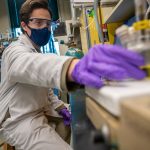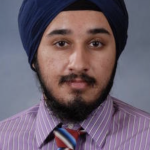Stephanie Akosa

Stephanie Akosa
Major: Physiology and Neurobiology, Minor: Psychological Sciences
Student Bio: Stephanie is a senior majoring in Physiology and Neurobiology and minoring in the Psychological Sciences. She has been a member of the neuropsychopharmacology lab of Dr. John D. Salamone, PhD, since the spring of 2019. The lab focuses on the effects of drug treatments for depression and other psychological disorders.
Aside from research, Stephanie is involved in other parts of the community. In her time at UConn, she has been a member of UConn’s Choirs and co-founded the UConn organization Knit for NICU. She has been a volunteer at Connecticut Children’s, where her passion for children’s health grew as she spent time with the pediatric patients. She has continued to serve the kids and families, raising funds for them as this year’s Director of Strategic Fundraising on the HuskyTHON Management Team. Stephanie has also spent time working as a volunteer at UConn Health’s Migrant Farm Worker Clinics.
In the fall, Stephanie will be continuing her education in pursuit of her medical degree at the UConn School of Medicine.
Title of Thesis: Development of Psychological Markers for Motivational Dysfunctions through the use of Tetrabenazine and Electroencephalograms in a Female Rat Model
Depression is an illness that is increasingly rampant in our society. With its prevalence, various drugs have become commonplace for treatment. Many of these drugs are serotonin reuptake inhibitors, or SSRIs. These drugs are able to mitigate symptoms of depression such as rumination and anxiety. However, they are not successful in treating the amotivation and anergia that are seen in these patients. In order to investigate which drugs will be the most successful in treating the symptoms of depression, it is important to develop a model that can accurately represent depression in humans. The goal of the present study was to use female rats to develop EEG markers that are relevant to the psychophysiology of female patients with depression. A within subjects control design with tetrabenazine (TBZ) as the independent variable was used on a group of 8 female rats. TBZ works by inhibiting the vesicular monoamine transporter 2 (VMAT2) to deplete the dopamine stores within the rats. Each rat was administered TBZ/Vehicle or Vehicle/Vehicle during 2 consecutive weeks (one treatment per week). Readings were taken each week from the frontal, parietal, and motor regions to investigate the effect that TBZ has on these regions and determine whether they are comparable to the neural state of female humans with depression. It was found that female rats have a peak at approximately 7-8 Hz that is suppressed when TBZ is administered. These findings can be used as a foundation for further studies that investigate how specific pathways are responding to administration of TBZ, and potentially how they are affected in those with depression.
Berk Alpay

Berk Alpay
Majors: Computer Science, Mathematics
Student Bio: Berk started his research career at the Eversource Energy Center and interned at the Fritz Haber Institute of the Max Planck Society in Berlin during the summer of his sophomore year. He is now doing computational biology research in the Aguiar Lab at UConn and the Marks Lab at Harvard Medical School. He has published two papers and is a STEM, Holster, Goldwater, and University Scholar, as well as an NSF Graduate Research Fellowship awardee.
Title of Thesis: A Probabilistic Model of RNA Constraints on Viral Evolution
Proteins are the basis of so much of what goes on in living organisms. Biologists are often interested in understanding how proteins work and in what ways they can be adapted. Let’s say you’re interested in which mutations damage the ability of the protein to do its task, and which don’t. The number of possible mutations to the DNA sequence that encodes the protein is enormous, and we have only finite resources to test out what works and what doesn’t. Fortunately, there’s been a huge experiment that does these tests and has been running for billions of years: it’s called natural selection. The mutants of our protein that exist in organisms in the world around us have gone through the test of fitness: they’re more or less what work.
You can align these mutant sequences and see whether there are any constraints. In this figure from a previous paper, the third site in the sequence appears to be constrained to be either the amino acid symbolized by A or D. We could guess that if we put some other amino acid at that position, it would cause the protein to not perform its function as well.
My thesis is about extending this kind of modeling to the nucleotide level. Although it’s normally a good assumption that amino acids are the main factor in determining the fitness of a protein, there can be selection on the particular nucleotides that encode the amino acid, especially in viruses where the RNA can have constrained structures.
Eduardo A. Badillo Colberg

Eduardo A. Badillo Colberg
Major: Molecular and Cell Biology
Student Bio: As a Molecular and Cell Biology major, Eduardo has been primarily involved in the STEM Scholar Community E-Board, Honors Program as a whole, Global Brigades and the Undergraduate Student Government through his undergraduate career as a leader in such groups. In addition working in the Angeles Boza laboratory in the Chemistry Department, primarly investigating novel Antimicrobial Peptides and how they work against particular bacteria. He enjoys listening to music, reading, and learning all things from cooking to exercise science.
Title of Thesis: Reeling in New Antibiotics: Synthesis and Antimicrobial Susceptibility Testing of Zinc-Binding Clavanins from Styela clava (Sea Squirt)
Bioactive peptides have been on the rise in investigative efforts as a potential use for them to be novel therapeutics, being potentially more effective and resilient against resistance. From these, the Clavanin family, more specifically Clav. A, has shown true promise against a variety of diseases, due to its structure and ability to bind to metals like Copper and Zinc through the ACTUN motif. Clavanin D and D(Tyr) have been identified as possible candidates as well for antimicrobial purposes. In this investigation we explored the aforementioned peptide in order to see if it acts similarly to its relative, and if its potentially better at killing bacteria.
Gaganjot Bedi

Gaganjot Bedi
Major: Molecular and Cell Biology
Student Bio: I was three years old when my parents immigrated our family from India to America. My parents began working in the healthcare field upon moving here and the joy they spoke with when discussing their jobs fueled my desire to join the profession myself. I made efforts to get accustomed to the field in high school, and continued with that path in college. I majored in MCB while taking part in community service through organizations like UCHL and HASB, as well as shadowing work. I’ve spent the past two years working with Dr. Sudha Srinivasan for similar reasons, as I’ve gotten the opportunity to work with children diagnosed with ASD and not only hone my research skills but also help individuals that need it. I plan to take a gap year after my undergraduate experience and then hopefully attend medical school to realize my dream of being a physician.
Title of Thesis: Assessing the Efficacy of Jellow: A communicative aid for children with ASD
The thesis is based on a research project conducted in the REINVENT-PT lab in the Department of Kinesiology at UCONN during the
2019-20 academic year. The project analyzed data collected as part of a longitudinal intervention study concerning children diagnosed with Autism Spectrum Disorder (ASD) using Jellow communicator. Jellow is a comprehensive communication system that was used to teach requesting skills in 17 non-verbal and minimally verbal children with ASD between 5 and 10 years through 20-30 minute intervention sessions that took place twice a week for three months. Trained therapists started by teaching children to request items by exchanging flashcards. As the child’s communication skills improved, the Jellow app was introduced which allowed children to use a built-in text-to-speech engine to make their request. All training sessions were videotaped for further coding, and a manualized coding scheme was used for a systematic assessment of the children’s training videos to assess the intervention-related changes in children’s quantity and quality of communication following the use of Jellow. The results indicated that the use of Jellow improved the ability for most children to communicate in regards to the stage of communication (whether they could use the app or still needed the cards), spontaneity (whether the child could initiate a request on their own), and attention throughout a task. Thus, these results indicate that a Jellow based intervention could be useful for children with ASD particularly if done continuously on a prolonged basis.
Project Slides - password required
Helen Bian
Helen Bian
Majors: Molecular and Cell Biology & Spanish, Minor: European Studies
Student Bio: My name is Helen Bian, and I'm a fourth-year student in the Special Program in Medicine. I'm very involved in my research project about Chronic Lymphocytic Leukemia, community service with the Kidney Disease Screening and Awareness Program, and ballroom dancing. I also have a passion for baking and learning foreign languages. I look forward to completing my medical education in the years to come!
Title of Thesis: Investigating the functional classification of known and novel single nucleotide polymorphisms (SNPs) associated with Chronic Lymphocytic Leukemia predisposition
Chronic lymphocytic leukemia (CLL) is a B-cell malignancy that is the most common form of leukemia affecting adults in western countries. Although there are known risk factors for CLL (e.g. old age), the cause of CLL is still unknown. Data suggest that genetics play a role in the disease etiology of CLL. Genome-wide association studies (GWAS) have identified over thirty single nucleotide polymorphisms (SNPs) associated with CLL. My research for my thesis seeks to investigate the genetic component of CLL, with a focus on GWAS-identified SNPs. The goal of my research is to identify causal SNPs that contribute to the CLL disease phenotype in order to better comprehend genetic variation. The broad objective of identifying causal SNPs is to better understand how genetic variation in noncoding regions contributes to development of diseases such as CLL, as well as how non-coding SNPs alter gene regulation in disease states.
Sam Bird
Sam Bird
Major: Ecology and Evolutionary Biology
Student Bio: I am an Ecology and Evolutionary Biology student who specializes in amphibians. I found my love for amphibians at a young age, handling various species of frogs at a pond by my house. My research focuses mainly on salamanders, specifically Eurycea bislineata, although I have done work related to Plethodon cinereus (the red-backed salamander) in the past. I am planning on doing environmental research in the future, hopefully related to amphibians. I also have a fondness for plants, and would love to do research relating to whole freshwater ecosystems. When I am not doing environmental research, I love to draw, as well as play board games with my friends and family. I also love taking walks with my dog, Snowy, who is turning ten this year.
Title of Thesis: Nesting Habits of Eurycea bislineata
For my project, I wanted to look at the nesting habits of Eurycea bislineata, the northern two-lined salamander, to see if they lay their eggs communally, in a group, or by themselves. Additionally, I was investigating what factors might cause them to pick the area they chose to lay their eggs over other locations nearby. In order to do this, I located two streams with nesting sites within them (typically under rocks in the streams) in the spring. Over the spring and summer, I visited these nesting sites and took photos of them on a weekly basis. I also established paired sites, one within three feet of each nesting site, as well as random sites, which were randomly selected rocks throughout the stream. For each of these sites, I measured the average water depth, stream width, distance from shore, canopy cover, and the surface area of the underside of the rock. I found that Eurycea bislineata appear to use a mix of communal and solitary oviposition. One salamander can lay up to about 50 eggs, and there were several nesting sites with more than that, one even having 709 eggs. However, in terms of nesting site selection, I could not find any significant differences between nesting sites and the random or paired sites for the variables that I checked for the two streams. As not much research has been done on communal oviposition in Eurycea bislineata, this is an interesting insight into how this species behaves. I would recommend repeated testing related to nest site selection for this species in the future, perhaps with other factors that I did not consider in this study.
Gavin Birdsall
Gavin Birdsall
Major: Physiology and Neurobiology, Minor: Mathematics
Student Bio: My name is Gavin, I am majoring in physiology and neurobiology and minoring in math. My research interests are cancer biology and genetics, specifically differential gene expression of aberrant cell types. I will be pursuing a PhD in the Biomedical Sciences program at the University of Massachusetts Medical School after graduation. I was originally Pre-Med until I started doing research my junior year, I then decided I wanted to continue similar work for graduate school. I hope to spend some time in industry and eventually return to a university to teach.
Title of Thesis: Using Single-cell RNA-seq Analysis to Assess Heterogeneity in a Model of Ependymoma Brain Tumors
Brain tumors are composed of a heterogenous mixture of tumor and non-tumors cells. Single-cell RNA-sequencing approaches provide opportunities to characterize this diversity at a level not previously possible. In my thesis project I have used scRNAseq analysis to characterize the diversity of tumor cells in a mouse model of supratentorial ependymoma (STEPN), a tumor type that in humans is characterized by a fusion between the genes C11orf95 and RELA, called FUS1. Single cell analysis was performed using two bioinformatics packages, with the goal of classifying the different cells types present in these tumors, as well as the predicting cell fate trajectory of the tumor cells expressing the fusion gene. Clustering reveals that a majority of the cells sequenced from the tumor sample express genes relating to immune cells, while only about 15% of the cells sequenced are expressing FUS1, indicating the presence invading immune cells as well as malignant cell types. Interestingly, we identified several unique clusters of FUS1 positive cells with distinct expression profiles relating to immune activation, NF-kB activation, and inflammatory response. We are preforming further analysis to explore immune activation within these clonal populations. The goal of this project it to better understand the heterogeneity of ST-EPN tumor cells and reveal how their genetic differences may influence the tumor microenvironment and modify immunological responses within the tumor.
Heather Boucher
Heather Boucher
Major: Chemical Engineering
Student Bio: My name is Heather Boucher, and this May I will be graduating with a degree in Chemical Engineering. Over the last four years at UConn I have been involved in several ways including the following: volunteer contact tracer with the UConn Health Leaders program, teaching assistant for undergraduate engineering courses, research assistant in a biotechnology lab, and vice president of Omega Chi Epsilon, a chemical engineering honor society. Outside of school I have participated in internships at Davis-Standard and Unilever, the latter of which I will start full-time in the upcoming summer. In my free time away from school and work, I enjoy the outdoors particularly backpacking and cross-country skiing!
Title of Thesis: Development of Sustainable Agriculture Biotechnology: Calculating Protist Velocity Distributions in Model Soil Transport Systems
The focus of my thesis is the development of sustainable agriculture biotechnology; specifically, calculating protist velocity distributions in model soil transport systems. Current commercial fertilizer dispersal methods are inefficient since they do not directly target the rhizosphere, which is where nutrient exchange occurs for plants. Protozoa are unicellular eukaryotes that are naturally found in the soil and have the potential to deliver nano-encapsulated nutrients to targeted plant roots.
My research has been investigating several protist species to determine optimal candidates for real-world targeted nutrient delivery applications. Using microfluidic devices that model soil structures, I determined the planar velocity of three protist species. I found a positive correlation between planar velocity and protist movement through a soil modeled microfluidic device. Based on this, I came to two conclusions. First, determining the planar velocity of a protist species is an accurate predictor for the ability of the protist to move through soil structures. Secondly, of the protists tested, Colpoda steinii had the highest velocity and would be the optimal candidate for farming applications. Although additional research is needed, this technology has the potential to make the American agricultural system more efficient and environmentally-friendly by limiting our dependence on topical fertilizers.
Nidhi Chawla
Nidhi Chawla
Majors: Physiology and Neurobiology & Women's Gender and Sexuality Studies
Student Bio: Nidhi Chawla is a senior double majoring in Physiology and Neurobiology and Women’s Studies graduating in May. She was a member of Dr. Crystal Park’s psychological sciences lab focusing on coping, spirituality and mindfulness in relation to health from the spring of 2018 to spring 2020. The project she was on conducted research on how personality traits and personal history can predict the way in which people react to laboratory tasks.
Aside from this research study, Nidhi was also an intern at St. Francis Hospital’s OB-GYN clinic under the supervision of Dr. Walter Trymbulak where she was involved in the production of a resource guide distributed to patients. She provided resource education to new obstetric and gynecology patients in coordination with clinic staff. Here she was able to further foster her passion for increasing accessibility when it comes to women’s healthcare.
In the fall, Nidhi will be attending medical school at Touro COM in New York.
Title of Thesis: Intersectionality, Access, and Women’s Health: Engaging and Enacting a Feminist Model of Health Care
“Intersectionality, Access, and Women’s Health: Engaging and Enacting a Feminist Model of Health Care” takes analytically the potential role feminist theory can play in the making of a more accessible and effective model of medical care. In terms of theory and methodology, this thesis draws upon Kimberlė Crenshaw’s influential notion of “intersectionality” as a means of mapping multiple identities and subjectivities; as an additional lens, the thesis accesses Audre Lorde’s insistence that one cannot rely on established systems as the basis for progressive politics. Consistent with the reflexive dynamics of intersectional feminism, and guided by the notion that the personal is indeed political, this thesis utilizes autobiographical reflection, familial history, and on-site ethnography to establish a distinct academic and professional trajectory. The thesis focuses on the experiences I had interning at St Francis Hospital’s OBGYN clinic where I was able to develop a resource guide that highlighted the main programs that were offered free of charge at the clinic. The demographic of the women who utilized this clinic for pre and post pregnancy needs were mainly of Black and Latina decent. This trajectory indicates an intersectional analysis of women’s health and contextualizes my use of feminist practice in a medical setting. While this thesis engages an intersectional analysis to promote a more holistic approach to women’s health, its focus is very much connected to past/present gender politics; this work is likewise framed by the larger interdiscipline of gender/sexuality studies and emblematic of my own location as a woman of color and feminist thinker.
Eve Cullerton
Eve Cullerton
Major: Natural Resources - Fisheries and Wildlife Conservation, Minors: Ecology and Evolutionary Biology & Chemistry
Student Bio: Hello! My name is Eve Cullerton. I am a senior in CAHNR majoring in Natural Resources with a concentration in Fisheries and Wildlife Conservation and minoring in both Ecology and Evolutionary Biology and Chemistry. My career goals involve studying how wildlife reacts to disturbance events and finding ways to protect both wildlife and their habitat from future exploitation. I have had the privilege to work with Dr. Tracy Rittenhouse studying how wildlife activity differs between harvested and unharvested wetlands for my honors thesis project. This project has given me the opportunity to study disturbance ecology first-hand and apply study results to management strategies. I am so thankful to have had the opportunity to expand my knowledge of scientific research, a skill that I will bring with me into any profession. A special thank you to all who made this project possible, including: Dr. Tracy Rittenhouse, my mentor and inspiration for continuing a career in wildlife; former graduate students Kristen Beattie, my go-to for all things R, and Daniel Wright, the man behind the trail cameras; and undergraduate student Annika Benedetti, who helped process the many photos required to finish this project.
Title of Thesis: A comparison of wildlife activity patterns in control and harvested wetlands of Connecticut
Natural wind throw events, beaver activity, and timber harvesting act to remove aspects of the forest canopy, which restarts understory growth within forested wetlands. How does this change in plant structure influence the wildlife in these wetlands? In this project, I am comparing daily activity patterns of mammals within control forested wetlands to wetlands where we experimentally felled trees. New England went through several decades with low abundance of beavers and low levels of timber harvest, thus forested wetlands now contain large trees. This research will enhance our understanding of how heterogeneity in the structure of forest canopies may enhance wildlife habitat.
UConn Forest Crew felled trees in three wetlands during winter frozen conditions in February 2019. We set-up 3 cameras within three control and three harvested wetland sites and monitored wildlife from November 2018-August 2020.
We obtained and processed 138,000 photos in CPW Photo Warehouse. I analyzed this data using the R package ‘overlap’ by creating density plots of mammal activity. I was able to compare the percent overlap of species activity in harvested versus unharvested wetlands.
I found that chipmunks only used control wetlands whereas deer showed a preference for harvested wetlands. Furthermore, my preliminary results indicate that browsers, such as deer and cottontails, may use wetlands with felled trees over longer periods of time in the day compared to unharvested wetlands.
Dhruv J. Dang

Dhruv J. Dang (DJ)
Major: Molecular and Cell Biology, Minor: Film Studies
Student Bio: Hi all! My name is DJ and I am currently a senior molecular and cell biology student at the University of Connecticut. I have participated in two main research projects as an undergraduate. The first was a summer internship at Brandeis University focusing on the fusion mechanisms of Influenza virus with host cells. My most recent research studies the impact of U.S. acculturation on obesity in Hispanic-American children. In my free time, I like to play sports, read novels, and mentor younger college students. I also love filmmaking! In addition to my film studies minor, I have helped produce a few short films as the director of photography. I am currently applying to medical schools with the hopes of becoming a physician one day (potentially in pediatrics!).
Title of Thesis: Language acculturation traits and BMI in Hispanic-American children from 1999-2004
Hispanic and Latino individuals make up the largest minority population in the United States, yet nearly half of all Hispanic adults suffer from obesity. U.S. acculturation has been linked to higher prevalence of specific lifestyle diseases in these adults, such as diabetes. However, the association between acculturation characteristics and screening measurements like BMI as a predictive model for adulthood obesity and disease in U.S. Hispanic children remains largely unexplored. I performed a retrospective database study using the National Health and Nutrition Examination Survey (NHANES) from 1999 to 2004 on Hispanic children 12-19 years who responded to acculturation questions. I created an acculturation scale based on the extent to which the subject used English or Spanish in certain situations: languages read and spoken, usually spoken at home, used to think, and used with friends. A value of 1 represents "only Spanish" while 5 is "only English," with total score ranging 4 to 20 for the following categories. Scores were classified as either least (4-7), less (8-11), more (12-15), or most (16-20) accultured to the U.S. I performed one-way and two-way ANOVA tests using RStudio to analyze language-acculturation data against BMI as the response variable, with country of birth serving as the second explanatory variable. The results revealed a stronger correlation between BMI and birth country, but a statistically insignificant relationship between BMI and acculturation scores. When accounting for birth country, the correlation between acculturation scores and BMI was statistically significant. I concluded that U.S. acculturation may not be sufficient in predicting BMI in Hispanic children; however, its association with other variables (like birth country) and whether language-specific traits accurately reflect U.S. acculturation need to be further assessed.
Mukund Desibhatla

Mukund Desibhatla
Majors: Physiology & Neurobiology and Spanish, Minor: European Studies
Student Bio: Mukund is a senior pursuing an Honors double major in Physiology & Neurobiology and Spanish with a minor in European Studies. During his junior year, Mukund became involved in undergraduate research in Dr. John Salamone’s Lab, where he has investigated the effects of various dopamine transport inhibitors on effort-related motivation in rats. Dr. Salamone guided Mukund in creating his own unique project, for which he received a SURF Award for Summer 2020. Driven by his passion for podcasting, Mukund also pioneered UConn’s first Podcast Symposium in February 2021, for which he received a UConn IDEA Grant to actualize this mission. In celebration of his diverse musical upbringing, he formed the Indian classical ensemble Riyaaz and is UConn’s second fellow of the Clinton Global Initiative University. Mukund has been able to use his passion for research and service as a Peer Research Ambassador to help students gain confidence in their creative endeavors.
Title of Thesis: The Evolution of Novel DA Transporter Inhibitors and their Effects on Effort-Related Motivation: A Review
Rats have become an ideal model organism to test the reversal effects of commonly prescribed antidepressants such as (S)-citalopram and fluoxetine. VMAT-2 inhibitor tetrabenazine and cytokine IL-1β can cause profound motivational impairments and shift choice behavior in rats. Although common selective serotonin reuptake inhibitors (SSRIs) are usually known to treat depressive symptoms, recent FR5 and PROG chow feed task procedures have shown the failure of these drugs to reverse the effects of tetrabenazine. In fact, these transport inhibitors even have the tendency to exacerbate symptoms and produce further impairments in rats such as psychomotor retardation, anergia, apathy, and fatigue. This data points to the inefficiency of common market SSRIs in battling depressive symptoms in patients. Since SSRIs are only applicable to serotonin reuptake pathways, research suggests that the atypical binding affinity of some DAT inhibitors could completely reverse the effects of tetrabenazine. The aim of my project was to assess known dopamine uptake inhibitors and other novel agents and evaluate their effects on reversing depression-like symptoms. This review was performed on five publications from the Salamone Lab with additional references found using the electronic database PubMed.
Sean Doolittle
Sean Doolittle
Major: Civil Engineering
Student Bio: My name is Sean Doolittle and I am from Windsor, CT. I am passionate about equitable and sustainable transportation/urban planning in my academics and career. These are connected to my passion for the outdoors, in which I love to ski, climb, and hike. I am also the secretary of the UConn Outing Club and Vice President of the UConn Freeski Team.
Title of Thesis: Using GIS to Support Established Ideas on the Harmful Impacts of Highway Construction Through New England Cities
The goal of this project was to create three different maps of downtown Bridgeport CT in three different time periods, 1913, 1954, and 2013. These maps are intended to show how the city developed and changed before and after the construction of the interstate that travels directly through the downtown. Specifically the goal was to show how the highway has encouraged an oversaturation of parking structures and amenities in favor of homes and businesses. The importance of mapping 1954 was that that was the year before construction began on the interstate. It was important to show how the city changed without the highway but still with the influence of automobiles from 1913 to 1954. The city was once a diverse and healthy ecosystem of mixed land use and now, since the construction of the highway, is heavily auto-dependent and struggling financially.
The secondary piece of this project, in collaboration with the Geography department, was to develop and carry out a methodology to use the data generated from the maps to perform a tax analysis of the downtown buildings in the three different years, to show the financial impact of the highway.
Shaharia Ferdus

Shaharia Ferdus
Major: Molecular and Cell Biology, Minor: Nutritional Sciences
Student Bio: Hello! My name is Shaharia (Shah-HAH-ree-ah) Ferdus (FAIR-those). I am a senior undergraduate student double majoring in Molecular and Cell Biology and Nutritional Sciences. I had the privilege of conducting research on the gut microbiota and liver health under the supervision of Dr. Christopher Blesso of UConn's Nutritional Sciences department. I am thrilled to have been able to combine my interests in cell biology, nutrition, and human health through this study, and to have gotten the opportunity to learn research methodology and lab skills. Special thanks to everyone who supported my research activities, including but not limited to Dr. Blesso, graduate students Liya Antony and Chelsea Garcia, as well as the Presidential Scholarship Enrichment Award committee.
Title of Thesis: Effects of Bacterial Lipid Exposure on Cholesterol Metabolism and Liver Inflammation in HepG2 Cells
Bacteroidetes are a phylum of microbes that make up a significant portion of the gut microbiota in healthy individuals. They produce metabolites that may impact health, such as serine-glycine lipids belonging to the Lipid 654 (L-654) class. Interestingly, L-654 lipids have been found in arterial plaques belonging to patients with atherosclerosis. This is a condition in which fats are deposited on the walls of blood vessels, causing them to narrow and harden, thereby increasing the risk for blood clotting, heart disease, and other metabolic illnesses, including liver disease (see figure). These bacterial lipids have been studied for their role in the development of atherosclerosis, but what about their effects on the liver, which is often implicated in metabolic disease? In this study, HepG2 liver cells were given one of three solutions: (1) a saline control containing no L-654 lipids, (2) a 0.5 mg/mL L-654 lipid solution, or (3) a 1.0 mg/mL L-654 lipid solution. After 24 hours of incubation, the cells were collected and the expression of genes involved in cholesterol metabolism and liver inflammation were measured because these markers can indicate liver health. PCR results showed no significant differences in gene expression of cholesterol metabolism and liver inflammatory markers, suggesting that L-654 lipids have no effect on liver health. However, it is possible that bacterial lipids act on other types of liver cells, like Kupffer cells, macrophages, or hepatic stellate cells. Further investigation may look at whether L-654 bacterial lipids impact these other types of liver cells, individually or in the context of the whole body; consider exposing the cells to the lipids for a longer period of time; or explore whether these lipids only act to reduce inflammation in an already inflamed disease state.
Project Slides - password protected
Michelle Franklin

Michelle Franklin
Major: Nursing
Student Bio: Michelle Franklin is a senior nursing student aspiring to become a pediatric oncology nurse upon graduation. She is an honors student, a member of the Sigma Theta Tau Nursing Honors Society, a leader within the HuskyTHON community, a member of the Student Nurse's Association, and an undergraduate researcher and recipient of the SHARE award to pursue her research goals. She is a strong mental health advocate and based her undergraduate research on better understanding the posttraumatic growth that can occur as a result of eating disorder recovery.
Title of Thesis: Posttraumatic Growth in Eating Disorders
Posttraumatic growth is a research topic of growing interest and is defined as the positive psychological change that can occur as a result of highly challenging life circumstances. A large body of research currently exists in relation to posttraumatic stress and posttraumatic growth following a variety of trauma types, however, there is currently no research conducted on the basis of posttraumatic growth following eating disorders. The objective of this convergent parallel mixed-methods study is to address this gap in research and to investigate the posttraumatic growth in individuals who have engaged in treatment for an eating disorder. This study sought to understand the levels of PTG in individuals who have engaged in eating disorder treatment, the extent that individuals believed their core beliefs were examined while recovering from an eating disorder, the relationship between demographics and core beliefs to posttraumatic growth, the posttraumatic experiences of those recovering from an eating disorder, and the strength of the quantitative and qualitative strands in creating a more complete picture of posttraumatic growth in those recovering from an eating disorder.
This mixed-methods study was conducted using an electronic anonymous study distributed via the internet, with a total sample size of 38 participants. The quantitative section included the posttraumatic growth inventory and the core beliefs inventory. The qualitative section involved participants answering the statement “Please describe in as much detail as you can remember the experiences of any positive changes in your beliefs or life as the result of an eating disorder”.
The quantitative and qualitative data obtained from this study support the presence of Posttraumatic Growth within individuals who have struggled with and received treatment for an eating disorder. Individuals who have suffered from an eating disorder undergo a type of trauma that allows them to grow within the five dimensions of Posttraumatic Growth, demonstrating that not only posttraumatic stress, but positive change can occur as a result of overcoming an eating disorder. The findings of this research study hold significant potential for uncovering elements of growth that can occur as a result of eating disorder recovery, which can in turn influence the development of eating disorder treatment programs to better support this growth process and create sustainable recovery within individuals suffering from eating disorders. The more this posttraumatic growth can be obtained within individuals, the greater the capability of maintaining a life in recovery.
Christopher Geiger

Christopher Geiger
Major: Computer Science & Engineering, Minor: Mathematics
Student Bio: Hello! My name is Christopher Geiger, I'm a graduating student in Computer Science & Engineering at the University of Connecticut, previously from Añasco, PR. During my time at the University of Connecticut I specialized in theory and algorithms, so most of my studies surround designing and analyzing the methods used to solve technical problems. In my personal life I like to play the electric guitar, lift weights, and write software or scripts for my own personal projects. Right now I've become particularly interested in building web applications and learning about web technologies. The research I contribute to is in the realm of biometrics, cybersecurity, and machine learning, I've been learning about the process of iris recognition and how attackers can use leaked information to generate data about their victims and authenticate as them. I feel lucky and grateful to work with Sohaib Ahmad and Dr. Benjamin Fuller on cybersecurity and iris recognition research!
Title of Thesis: Resist: Reconstruction of irises from templates
Iris recognition software is a newly emerging technology that allows users to login (or authenticate) with just an image of their eye. We can use iris recognition to unlock cell phones, open doors, login to websites, and more. This raises a new question, is it possible for an attacker to "break" the iris recognition system and login as their victim by creating a fake image of their target's eye? Resist is a machine learning architecture that uses leaked information from iris recognition systems to generate realistic iris replicas. Normally, iris recognition systems work in a single direction, they take an iris image and then convert the image into a list of numbers (called a template). This template is later used to verify a user's identity -- whenever a new image of a user's eye is taken, the iris recognition pipeline is run again, generating a list of numbers by extracting information from the new photo. If these numbers are close enough to those from the template, the user is granted access. Resist inverts this iris recognition pipeline, using leaked template information to create an image that looks similar to a victim's iris. Once a realistic replica iris has been created, it can be used in a presentation attack to authenticate as the victim. Ideally an attacker would be able to essentially print out the replica iris image, then authenticate as the victim by showing the printout to the iris recognition device.
Adrian Gibson
Adrian Gibson
Major: Electrical Engineering
Student Bio: I am a fourth-year student at the University of Connecticut studying Electrical Engineering and Spanish. My primary research interest is in interdisciplinary approaches to sustainability and renewable energy technology. I am also interested in languages and linguistics, and I have studied Latin, Spanish, Catalan, and Mandarin Chinese. Outside of academia, I enjoy drawing, hiking, and appreciating the natural world.
Title of Thesis: Light Intensity Modulated Impedance Spectroscopy for Photovoltaic Panels
The purpose of my honors thesis is to design a system that can non-invasively determine the aging of a photovoltaic panel. Photovoltaic panels, popularly known as solar panels, are an important clean energy technology that has taken off in the last ten years. However, in order to effectively utilize PV panels over the long-term timescale, it is important to know their aging characteristics as they decrease in output and efficiency over time. When PV panels age, their internal electrochemical properties change. These electrochemical properties can be measured using a process called impedance spectroscopy, where a small AC signal is applied to the panel and the resulting output is measured.
Most IS procedures for PV panels require the panel to be disconnected and a reverse voltage applied using special equipment. Our project, on the other hand, seeks to perform IS by varying the light incident on the panel at certain frequencies. In order to do this, several different systems are needed. The first is an LED driver, which controls the light emitted by an LED to provide the input AC signal. Then, a current and voltage sensing circuit is needed to collect the output current and voltage of the PV panel, and send this data to the computer using a data acquisition device. Finally, the raw voltage and current data must be processed to extract the impedance of the panel at different frequencies, and the overall impedance characteristics of the panel over the full frequency spectrum.
Samhita Gurrala

Samhita Gurrala
Majors: Nutritional Sciences & Women's, Gender, and Sexuality Studies
Student Bio: During my four years here at UConn Storrs, I've been able to make wonderful memories and friends, complete two degrees in different colleges, travel abroad to shadow physicians in Lisbon, Portugal, go on an alternative break about food insecurity in urban environments, volunteer with the Collegiate Health Service Corps, and last but not least, become a captain of UConn Surya (Bollywood fusion dance team). After graduating in May, I will be attending UConn School of Medicine in the fall. I'm really excited to pursue my journey of becoming a physician with background in my undergraduate majors of Nutritional Sciences as well as Women's, Gender, and Sexuality Studies. My goal is to be part of a change in the healthcare system and serve communities with preventative medicine and a social justice perspective. Some of my hobbies include cooking, dancing, painting and reading.
Title of Thesis: The prevalence of tooth loss and chewing problems and their association with dietary quality and health status in mobile food pantry users
Dental and oral health is an essential part of overall health and well-being as tooth loss and chewing problems are potentially linked to poor diet quality and negative health outcomes. In addition, populations who rely on food pantries to feed themselves and their families may be at a greater risk for having poor dental health due to lack of access to dental services. Using data collected from food pantry users in Windham County, CT, this study was aimed to document the prevalence of tooth loss and chewing problems in this vulnerable population and to examine the association between tooth loss and chewing problems and dietary quality and health status. Data collected from the participants included presence of tooth loss and/or chewing problems, dietary data, sociodemographic characteristics, as well as anthropometric measurements. Significant findings include a higher prevalence of tooth loss and chewing problems in food pantry users compared to the average population, especially in those over the age of 50. In addition, among participants with tooth loss and chewing problems, there was a decrease of consumption of certain food groups, most notably whole grains. These findings are important to consider for future research on developing nutrition education and interventions in low income populations who have scarce access to food, and more studies need to be done on the extent of this issue.
James He

James He
Major: Molecular and Cellular Biology, Minors: Neuroscience and Mathematics
Student Bio: James He, from Woodbridge, CT, is graduating this semester with a degree in Molecular and Cellular Biology as well as minors in Mathematics and Neuroscience. On campus, he is involved as an undergraduate researcher in the LoTurco Lab, a violinist in the UConn Symphony Orchestra, the Director of Programming of the Kidney Disease Screening Awareness and Prevention Program (KDSAP), and the Program Director for America Reads. His experience working with younger students and passion for medical science motivate him to pursue service- and science-centered activities in his career. He hopes to gain training from an M.D./Ph.D. program that can prepare him to become a physician-scientist aiming to develop better cancer therapeutics. In addition to his academic pursuits, he is a nature lover, card game strategist, and basketball enthusiast.
Title of Thesis: Identifying the Cell Composition and Clonal Diversity of Supratentorial Ependymoma Using Single Cell RNA-Sequencing
Ependymoma is the third most common type of pediatric brain tumor with very limited treatment options. Regardless of location, standard treatment for these tumors involves extensive surgical resection followed by local radiation therapy, which may incur complications in the developing brain. One subtype, supratentorial ependymoma (ST-EPN), is particularly aggressive and has been found to be driven by an oncogenic fusion mutation. Molecular characterization of this mutation has allowed the LoTurco Lab to develop a new mouse model of ST-EPN, which can be used to study the different mechanisms of tumorigenesis. My project involved a combined computational and experimental approach to define the molecular signatures of ST-EPN cells and to unravel the heterogeneous cell populations present in ST-EPN tumors. From an initial sample of over 40,000 cells from a mouse ST-EPN tumor, single-cell RNA-sequencing generated a transcriptomic profile of each individual cell. Using advanced computational software, we clustered cells into groups sharing similar gene expression signatures, inferring that they represent a common identity. A distinct group of malignant fusion-expressing cells was identified that could be further re-organized into distinct cell types of the malignant tumor microenvironment. Of significance, these cells have vastly different gene expression signatures compared to non-malignant immune, stromal, and neural cell types also found in the tumor sample. Such differences drive increased cell proliferation, immune response, and metastatic potential through angiogenesis and cell migration. Honing in on the specific genes involved in these functions may yield insight into the malignant properties of ST-EPN tumors, and the specific mechanisms that drive tumorigenesis.
Project Slides - password protected
James Edward Lee Hormann

James Edward Lee Hormann
Major: Mechanical Engineering
Student Bio: I'm a Mechanical Engineering student originally from Missouri. I play guitar, I love to travel, and I'm an extrovert. I'm passionate about a wide range of studies, and I'm excited to talk about my research into advanced radiation heat-transfer models.
Title of Thesis: Computational Validation of Several Radiation Heat Transfer Models
The purpose of this thesis is to explore the range of available radiation heat-transfer simulations and compare the results to textbook examples and then experimental results. This has the two-fold benefit of testing commercial software accuracy and potentially supporting experimental results through computational methods. Careful simulations and creations of computational models can be useful in validating experimental results, but the goal is to have a framework to predict the results of similar cases and thus reduce the number of required experiments.
Project Slides - password protected
Amar Kalaria

Amar Kalaria
Major: Physiology and Neurobiology, Minors: Molecular and Cell Biology, Healthcare Management and Insurance Studies
Student Bio: Since a young age, I have had a strong interest in healthcare and medicine. My interest stems from a desire to directly impact the lives of individuals and improve the wellbeing of underserved communities. At UConn, I have taken opportunities to develop this passion and become familiar with the field. Beginning my sophomore year, I have conducted research in the Conover lab and explored how my work can impact clinical outcomes. This experience has enabled me to think critically about stem cell biology and developmental neurobiology as well as refine my laboratory skills. Additionally, I am actively involved on the CLAS Student Leadership Board and serve local communities through KDSAP. In my free time, I enjoy playing basketball with friends, learning about business and entrepreneurship, and competing on a cultural dance team. Following my undergraduate career, I hope to attend medical school and pursue my goal of becoming a physician.
Title of Thesis: Lineage Tracing of Stem Cell Division Along the Lateral Ventricles During Early Embryonic Ages
My project is a study of the ventricular-subventricular zone of the lateral ventricles of the mouse brain, a site where new neurons are formed. This prominent stem cell niche is capable of generating new neurons and glial cells to populate the developing brain. These stem cells give rise to ependymal cells, which function to help circulate cerebrospinal fluid and aid in waste clearance. I am focused on the mechanism by which the stem cells divide to form ependymal cells and how this is reliant on developmental time point and position (caudal-rostral gradient) along the lateral ventricle wall. In order to monitor stem cell differentiation, I will use a method called lineage tracing, which tracks the progeny of a single cell.
Specifically, I am interested in determining whether the stem cells are dividing symmetrically or asymmetrically. Symmetric division would be shown by the radial glial cells dividing into either two stem cells or two ependymal cells. In contrast, asymmetric division would generate one stem cell and one ependymal cell. My hypothesis is that earlier divisions are largely asymmetric to support stem cell number retention, whereas the final rounds are symmetric to deplete the stem cell pool. The data I collect will be used to generate a computational model that can serve to predict developmental alterations in cases of hydrocephalus or other development brain disorders. We hope to provide clinical insight on the best way to treat this condition by studying curvature and stem cell development along the lateral ventricles.
Mita Kale
Mita Kale
Major: Ecology and Evolutionary Biology, Minor: Anthropology
Student Bio: Mita is a senior Ecology and Evolutionary Biology major who is especially interested in the evolutionary history of animals. She participates in research in the Bolnick EEB lab. Outside of class, she is president of the club Revolution Against Rape and a student employee at the Rainbow Center. She plans on pursuing a medical degree after graduation.
Title of Thesis: The Effects of Infliximab on the Fibrosis Response of Threespine Stickleback Fish
I ran an experiment to see the effects of the monoclonal antibody drug Infliximab on the fibrosis response of threespine stickleback fish. Some of these fish exhibit an immune response where their organs fibrose and begin to stick together after infection from a parasite. Humans also have a fibrosis response, and there are certain drugs that are available to treat this. Infliximab was chosen to see if it would significantly suppress the fibrosis response in the stickleback. In order to provoke the fibrosis response, we used injections of aluminum phosphate. All injections for the four treatment groups were given intraperitoneally. If this drug is effective, we could potentially run experiments where certain immune responses could be observed in isolation.
Pranati Mathur

Pranati Mathur
Majors: Biological Sciences & Women's, Gender, and Sexuality Studies
Student Bio: My name is Pranati Mathur (she/her), and I am a senior undergraduate student pursuing a Biological Sciences degree and a minor in Women’s, Gender, and Sexuality Studies. On campus, I am involved in UConn Community Outreach, through which I have tutored at local middle and high schools. I am also a member of a dance group at UConn that specializes in Indian classical music forms and performs at cultural events on campus. In my free time, I love to hike and explore different state parks in Connecticut, play the ukulele and guitar, and attempt new baking recipes with my sister. I have a strong passion for clinical research that allows me to directly impact the people I am working with, so I plan to take a gap year after graduation and continue pursuing clinical research before attending medical school.
Title of Thesis: Characterizing Drumming Imitation Capabilities in Children with Autism Spectrum Disorder
Autism is a spectrum of closely-related disorders that may affect an individual’s socialization, communication, and motor coordination skills. The sedentary lifestyle that often comes with having Autism Spectrum Disorder (ASD) impairs both the physical health and social outcomes of children with the disorder. Thus, the Play and Move Study was created by Dr. Sudha Srinivasan, PT, PhD and Dr. Anjana Bhat, PT, PhD, to target both the perceptuo-motor and socialization impairments in children ages 6-12 with ASD. The study has two intervention groups: a play-based group that incorporates yoga, dancing, and other creative movements, and a general exercise-based group that focuses on structured strength-based training. For my project, I have decided to analyze drumming, one of the activities done during the program to assess multi-limb coordination as well as the imitation capabilities of the participants. I have viewed video recordings of the Play and Move Study sessions and assessed the drumming performance of 10 participants using a standard coding template. The template accounts for spatial and temporal factors such as movement accuracy and precision, pace, rhythmicity, and symmetry. I have compared each participant's pretest and posttest sessions that occur at the start and end of the 8-week training period. My analysis of the participants’ drumming performance is just a small component of a bigger analysis that will give insight into the effectiveness of the training program, and which group specifically -- the play-based or exercise-based -- results in better health and wellness outcomes for children with ASD.
Project Slides - password protected
Mariam Mohsin

Mariam Mohsin
Major: Biomedical Engineering
Student Bio: My name is Mariam Mohsin and I’m from Stamford, CT. I’ve loved my time at UCONN these past four years and I’m going to be moving to Boston this summer for a job in medical technology. I’m really excited to be working with an engineering company in healthcare to improve lives. I have interned in the past at a couple companies which have greatly improved my technical skills and business place skills. Some things I like to do for fun are swim and cook interesting recipes that I see on TikTok. I’m looking forward to continuing my career in medical technology in the future and will never forget the time I spent here at UCONN with friends I can now call family.
Title of Thesis: Deep Learning Methods for Classifying Sleep Apnea
My honors thesis will focus on designing a new deep learning method (machine learning) to classify a sleeping disorder known as obstructive sleep apnea. This will be done by using EEG, ECG, or both signals from patients in a public physionet database. The general outline will be taking these raw signals and feeding it to a deep learning method of my choosing and learning about/testing the different design parameters to come up with the optimal solution.
This project is beneficial in the current climate because it allows for quicker diagnosis of sleep apnea that is much less labor intensive since it uses a computer algorithm instead of a sleep technician. This would assist people who believe they may have obstructive sleep apnea to seek treatment as soon as they are aware of the problem. The difference between my honors thesis and my senior design plan is the use of a deep learning method with avoids computing and selecting features manually. This is a step that was taken in my machine learning classifier for senior design however after completing that work it is clear that this is a very time consuming and difficult step. By avoiding this altogether it brings a different way of using the raw data directly to feed it through a deep learning method. I will be hoping to achieve an accuracy score of 70% at least using this deep learning method (possibly a convolutional neural network).
Giridhar Murali

Giridhar Murali
Major: Molecular and Cell Biology, Minor: Anthropology
Student Bio: My name is Giridhar Murali, and I am a MCB major and Anthropology minor in the Honors Program at UConn as a STEM Scholar! When I am not in class or studying, you will find me entrenched in front of a chess board for hours on end as a competitive player, playing Indian Carnatic music on the violin, volunteering my time as an EMT, or doing lab work! As an immigrant and hopeful first-generation physician, I have been fascinated in addressing the health disparities that plague our societies. With the COVID-19 pandemic and my deep understanding of virology, the past year has been both profoundly saddening and exciting at the same time. On UConn’s campus, I am proud to be a part of the CT Phi Beta Kappa chapter, UConn Rescue, Honors in STEM, PATH, and UConn Chess!
Title of Thesis: Isolating Compounds that Inhibit EV 71 Virus
I want to start off by acknowledging what a time in our history to be researching viruses. With the global SARS-COV-2 pandemic that has claimed 2.6 million lives around the world and climbing, I believe it is research like mine that will be useful to hopefully prevent the next pandemic. My research at UConn is about finding a new antiviral drug and/or therapeutic to prevent the onset of Hand, Foot, and Mouth disease in young children caused by Enterovirus 71 (EV 71). For those of you out there that may not be familiar with this disease, it causes painful blisters in the Hands, Feet, and Mouth, along with fever, shortness of breath, and other flu-like symptoms. There is currently no treatment for it, especially because it is a viral illness in nature. My research involves basic transformation of E. coli with EV 71 genes, protein purification of the 2C protein, and drug screening through an ATPase assay. The 2C protein is one of the most highly conserved protein domains in the Enterovirus family, and is thus key to target because it aids in viral replication. By using this protein and being able to visualize ATPase activity by measuring the corresponding fluorescence emitted from each reading, the effectiveness of the antiviral can be deduced. Through my research, I have been able to find 2 antiviral compounds that significantly inhibit this activity, and would need to be tested for FDA approval in the future!
Aryan Naik

Aryan Naik
Major: Physiology and Neurobiology
Student Bio: Hi, I'm a Physiology and Neurobiology major here at UConn. While at UConn, I've had the opportunity to meet some amazing people, do some amazing research, and learn so much. I have gotten to join so many wonderful organizations on campus, including UConn Lions, and USG.
Title of Thesis: Investigation of the role of PGBD5 in neuronal migration through CRISPR-cas9 activation
PGBD5 is a highly conserved gene in vertebrates from over 500 million years ago and is found in many species. In humans, PGBD5 is a Class II transposon that has retained endonuclease activity. Although it does not have flanking inverted terminal repeats (ITRs) to transpose itself, it has been observed to cause genomic rearrangements at PGBD5 specific sites (PSS), and promotes oncogenic mutations (translocations, deletions, inversions of tumor suppressors) associated with soft tissue rhabdoid tumors in children. However, in non-pathological states, Pgbd5 is most highly expressed in the brain, specifically in pyramidal cells in the neocortex during early development. Little is known of PGBD5’s role in the brain. While its only other known activity is associated with genomic rearrangements and rhabdoid tumors, this study aims to determine the function of the transposon within cortical cells. Preliminary data suggests that this gene affects neuronal development and migration and is thus of particular interest. In the LoTurco Lab, we utilized the SAM CRISPR activation system which drives expression of PGBD5 through recruitment of transcription factors to the promoter.
Project Slides - password protected
Colt Nichols

Colt Nichols
Majors: Biomedical Engineering & Electrical Engineering, Minor: Mathematics
Student Bio: Colt Nichols is from Portsmouth, RI and the son of Diane and George Nichols (UConn Alum). Colt is an Eagle Scout, a member of the UConn men's track and field team, and an Honors and STEM Scholar. He is an IEEE member, taught several courses as a TA, assisted in research and contributed to several innovation projects such as the development of an emergency ventilator prototype for UConn Health's Covid-19 response. His senior project "UV-C Light Sterilization Mask Technology and Prototype" and honors thesis both aim to use his interdisciplinary BME and EE experience to provide better care for all.
Title of Thesis: Analysis of Low Cost Wearable Biomedical Devices as a Method for Disease Prevention
This thesis is a culmination of my experience in Biomedical and Electrical Engineering. Continuous advancements in electronics have made the use of wearable electronics increasingly available to the average person. The practicality of producing wearable biomedical devices, has improved both tremendously both financially and in usability. I will analyze the technologies in development and currently available in the interest of identifying prospective applications. The goal of this thesis is to provide an interdisciplinary analysis on the option of wearable biomedical devices. In particular, I will evaluate their ability to improve the quality and timeliness of personal biometric information. The development of these services would greatly improve societal ability to prevent disease. This topic is more relevant than in previous times, considering the massively disruptive Covid-19 pandemic currently at hand.
Veda Pandya
Veda Pandya
Major: Mechanical Engineering
Student Bio: Hi! My name is Veda Pandya and I am from Stamford, Connecticut. I am a mechanical engineering major in the honors program at the University of Connecticut. My primary academic interest is in mechanical design for aerospace applications. I am thankful for the wonderful opportunities I have had to pursue my professional interests both in and outside of the classroom. My work as an intern at NASA focused on the mechanical design of attitude control systems for sounding rockets and sparked my interest in system design for aeronautical components. Some of my non-professional hobbies include playing tennis, hiking, and travelling!
Title of Thesis: Aerodynamic Optimization of Aircraft Wing
It is crucial that an aircraft be aerodynamic in form to overcome the forces of gravity and drag while in flight. The proper lift and thrust enable the aircraft to move optimally. Fuel consumption is directly proportional to aerodynamic drag. Thus, inefficient aircrafts that are subject to large drag forces are often costly. The wing of an aircraft can be designed to maximize lift and minimize drag. For a set of operating conditions including vehicle altitude and speed, the lift to drag ratio can be maximized to ensure the most efficient operation. The lift to drag ratio is dependent, in part on the geometry of the aircraft wing. The most optimal wing shape is unique for a set of operating conditions. This paper explores the ideal wing geometry of an aircraft travelling at a low speed, in the range of forty to sixty miles per hour. The ideal wing of this aircraft will seek to maximize lift, which is a function of the given aircraft velocity. The final design of the optimal aircraft wing, presented as a Solidworks model, accounts for the ideal lift to drag ratio at the given speed, the attack angle and its impact on drag, and the local air pressure.
Parth Patel

Parth Patel
Majors: Molecular and Cell Biology & Political Science
Student Bio: Parth is pursuing a dual degree in molecular and cell biology and political science on the premedical track. He is originally from South Windsor, Connecticut. Parth is highly involved in clubs and organizations on campus including being the President of the CLAS Student Leadership Board and Asha for Education, as well as being the Conference Director of UConn Model United Nations. As an aspiring physician, I am highly interested in dedicating my career to addressing healthcare disparities. Almost everything you look at in medicine or in any field can end up having sociopolitical implications. Therefore, I hope to use my interdisciplinary background to work on changing medical practices along with healthcare policy to better our national healthcare system.
Title of Thesis: Assessing the Receptiveness of Underrepresented Children towards an Emergency Department Pre-Post Intervention on Physical Activity
An adolescent’s perception of physical activity is important to understand to find ways in which physical activity attitudes and behaviors can be improved in the long term. Underrepresented youth are often not studied in the field as often and therefore need to be surveyed in order to understand the racial and socioeconomic influences on attitudes towards physical activity. The purpose of this study is to find ways in which underrepresented youth can be assessed on attitudes and find ways the best methods to educate and intervene.
This study is a cross-sectional survey. The target population is underrepresented youth in the healthcare system who present to the Emergency Department of CT Children's between the ages of 12-18 years old. They must be enrolled in public insurance in order to be viewed as being a part of the underrepresented population. However, the analysis of racial differences of children with regards to the acceptance of interventions has never been done through a pediatric Emergency Department (ED).
Due to underserved youth presenting to the emergency department (ED) more frequently compared to their counterparts, the setting of the ED must be examined further as a possible educational setting to reach this patient population. The purpose of this study is to determine the receptivity of underserved youth in receiving an ED-initiated intervention on the topic of physical activity. Secondary outcomes include assessing the comfort level of youth to discuss physical activity in the ED as well as determining the best methods to receive educational materials on the topic of physical activity.
Meryl Pookkattu
Meryl Pookkattu
Majors: Physiology and Neurobiology & Psychology
Student Bio: I am a pre-medical student double-majoring in PNB and Psychology from NJ. At UConn, I have been an undergraduate research assistant in the Sensory Perception and Neuroscience lab studying the neurobiology of sound perception using rats under the tutelage of Dr. Heather Read and Dr. James Chrobak. Outside of academics, I am the President of two student organizations on campus: Chi Alpha Campus Ministries and Honors in STEM, and a mentor for Peer Allies Through Honors. Additionally, I work as a pharmacy technician, with several years of customer service experience prior. After graduation, I hope to apply to medical school and make a difference by working with AmeriCorps. In my free time, I like to watch true crime documentaries on Netflix, plan out new spreads for my bullet journal, and spend time with loved ones. Fun fact: tater tots are my favorite potato products.
Title of Thesis: Rats as Model Systems for Auditory Discrimination Tasks
Despite their relatively small frame, it is no secret that rats have made a sizable contribution to biomedical research and the advancement of human healthcare. These so-called “lab rats” have been used as physiological model systems of human disease for decades and have allowed for the elucidation of mechanisms of several disease states including obesity, cancer, and neurological deficits. One way rats are used in behavioral neuroscience is through auditory discrimination tasks to study how sound perception works in the brain. Through operant conditioning, rats are trained in the auditory discrimination tasks for the purpose of tracking auditory processing through various cortical structures, including the primary auditory cortex (A1), medial geniculate body (MGB) of the thalamus, and caudal suprarhinal auditory field (cSRAF) to name a few. Through this research, rats can be trained to distinguish sounds between duration and frequency and later, through electrocorticography (ECoG), their brainwaves can be recorded to gauge arousal and attention state of the animal and for further analysis of behavior. My project will encompass why rats are used for auditory cortical processing research, discuss previously used methodologies of auditory discrimination tasks, and examine clinical applications of this field of study.
Daniel Schwartzman

Daniel Schwartzman
Major: Psychological Sciences, Minor: Healthcare Management and Insurance Studies
Student Bio: Hey everyone, My name is Daniel Schwartzman and I am a graduating senior majoring in Psychological Sciences and minoring in Healthcare Management and Insurance Studies. I am from Brooklyn, New York but am currently living off campus in Storrs. My family immigrated to the U.S from Ukraine in the late 90s. I have one younger brother who is in high school and am fluent in Russian. After graduation, I will be moving back to NYC to pursue a legal education and hopefully become a lawyer one day. Some of my favorite UConn hobbies have been playing basketball, tennis, studying at Homer B and going to the rec center after classes. I am certainly going to miss the long nights that I spent studying in the library with friends. Graduation still feels a bit surreal. This summer, I look forward to relaxing and preparing for law school.
Title of Thesis: A Scoping Review of Employee Wellness Interventions
Throughout the past year, the COVID-19 pandemic has repeatedly forced people around the world to adjust their lives and daily routines. Individuals are facing unprecedented amounts of stressors as a result of the pandemic on a daily basis. The risk of contracting the disease from co-workers, family members or patients has fostered xenophobic culture that is further compounded by strict social distancing guidelines (depending on location). Research has shown that loneliness and depression are on the rise, with the CDC reporting that 40% of U.S. adults were struggling with mental health or substance abuse in June 2020. Many individuals reported having experienced disproportionately worse health outcomes, increased substance abuse and elevated suicidal ideation. As a result of these factors, it is evident that there will be low morale at work in various settings.
Given that the pandemic will not be over anytime soon and life will not return back to normal for some time, it is important for employers to provide supports for their workers in these times. It is evident that compiling a list of interventions that have been empirically proven to be effective is necessary . In this project, we report on findings from a scoping review of employee wellness interventions found in peer-reviewed published literature with a specific focus on those that would be helpful for teachers in school settings. The goals of the project are to determine the scope of research available on employee wellness interventions and to identify the alignment with the guidance that the CDC provides.
Mallika Shekhar
Mallika Shekhar
Major: Physiology and Neurobiology, Minor: Neuroscience
Student Bio: I am a senior PNB major who is interested in pursuing the field of medicine after graduating. I hope to be a physician and focus on neuroimaging and neurology. As an undergraduate, I was part of Dr. John Salamone’s lab in the Psychology department, focusing on neuropharmacology research. Aside from that, I am also on the CLAS Leadership Board, Honors in STEM, MedLife, Collegiate Health Service Corps, and Husky Bhangra.
Title of Thesis: Investigations of binge-like behavior in female, Sprague Dawleys: effects of the catecholamine uptake blocker Lisdexamfetamine and dopamine antagonist Haloperidol
Binge eating disorder has a lifetime prevalence rate of 1.4%, and typically occurs at a higher rate in women than in men. Due to this fact, this study’s focus is on binge-like eating behavior in female, Sprague Dawley rats, induced using Cadbury’s milk chocolate, and how lisdexamfetamine (LDX), a catecholamine uptake blocker and a d-amphetamine prodrug that was approved for the treatment of moderate to severe binge eating disorder, effects this behavior. Previous research conducted in female Wistar rats showed a significant increase in rats’ intake of chocolate over time with a significant decrease upon LDX administration. This experiment is being conducted to see if there is any strain difference on acquisition of the binge-like behavior and/or effect of LDX. Within the experimental design, these rats are not under any food restriction and have ad libitum access to standard laboratory chow in their home cages. During a session, rats are placed in feeding chambers with a ceramic dish of chocolate for one-hour. The rats only receive chocolate during these sessions. Currently, results show binge-like behavior was induced using chocolate in the female Sprague Dawley rats, LDX significantly reduced the chocolate consumption at the highest doses, and there are no differences that can be seen between the two strains. Future work will aim to reverse the effects of LDX using haloperidol, a dopamine (DA) D2 receptor antagonist. LDX works primarily on DA, by introducing haloperidol to the system it is hypothesized that the reduction in chocolate intake induced by LDX may be reversed.
Siddarth Suresh
Siddarth Suresh
Major: Computer Engineering, Minor: Math
Student Bio: I am a senior majoring in Computer Engineering. I’m originally from Stamford, CT but moved to Georgia after my freshman year. In my time at UConn, I have done research in the Cyber-Physical Systems Laboratory alongside Dr. Song Han as well as the NASA Resilient Extra-Terrestrial Habitats Institute (RETHi) alongside faculty and graduate students from UConn and Purdue University. Through my coursework in Dr. Krishna Pattipati’s Control Systems and Digital Control Systems courses I gained a deep interest in that subject. For this reason, I chose a senior design project in flight controls, where I could directly apply the knowledge I gained from these courses. After graduation, I plan to enter the industry to gain more experience before pursuing higher education. In my spare time, I like to hang out with my friends, play poker, and watch Avatar: The Last Airbender.
Title of Thesis: Modern Helicopter Flight Control System Design
In the operation of conventional helicopters, pilot workload is an important engineering concern. The US FAA defines workload as “the relationship between an individual’s capacity to perform a task (mental and/or physical) and the level of system and situational demands associated with the performance of that task.” Undoubtedly, the greater the workload the pilot must endure, the less ability they have to react to unanticipated disturbances. The use of Flight Modes has become the norm for many years to accomplish the task of reducing pilot workload. These selectable modes for pilots allow them to vary the amount of software-assisted flight control as desirable for the mission at hand.
In this project, that same philosophy was applied on a smaller scale to a flight control software called PX4, which is run on unmanned aerial vehicles (UAVs), more colloquially known as drones. This additional “assisted” flight mode is called “attitude-command, velocity hold”. It is important to note that this is not a fully autonomous flight mode but rather one that simply reduces the number of responsibilities of the pilot. As the name suggests, the flight mode holds the velocity of the drone by commanding its attitude, the drone’s orientation about various axes. The pilot still has the ability to change the desired velocity of the drone via the RC transmitter. This flight mode is designed in MATLAB’s Simulink software package before being converted to C/C++ code that can be run in the existing PX4 flight stack. Testing of the flight mode is done via software-in-the-loop (SITL) testing in the jMAVSim and Gazebo flight simulators.
Jason Vailionis
Jason Vailionis
Major: Ecology and Evolutionary Biology
Student Bio: I will graduate from the University of Connecticut in August 2021 with a major in Ecology and Evolutionary Biology. My senior honors thesis project focused on understanding the convergent 'taming' of a formerly pathogenic fungus into a beneficial symbiont in North American dog day cicadas with Dr. Chris Simon. Contrary to previous understanding, I found this entire lineage housed these fungi and also began efforts to sequence the genomes of three representative symbionts. I plan to bring my bioinformatics expertise to a new project modeling bacterial metabolic networks for biofuel production at the University of Rhode Island where I will work with Dr. Ying Zhang in Fall 2021.
Title of Thesis: Symbiont Replacement by Pathogenic Fungus in the North American Dog-Day Cicadas
I investigated the evolution of a symbiotic relationship between cicadas, bacteria, and fungi. Cicadas are insects which feed on water from plant vascular tissue, a diet lacking in essential amino acids and B vitamins. Therefore, they rely on bacteria and fungi to meet their nutritional needs. Surprisingly, these beneficial fungi evolved from deadly fungal pathogens in the genus Ophiocordyceps, meaning cicadas have essentially tamed and domesticated the fungi, and there is evidence that this has happened not once but over a dozen times. The cicada-fungal symbiosis has only been discovered within the past decade, so little is known about its full extent. I focused on establishing a baseline understanding of 1) how many times Ophiocordyceps fungi have been domesticated by cicadas in nature, and 2) what the evolutionary history of cicada-associated fungi looks like. To do this, I sampled 29 species of cicadas from one large North American lineage, and dissected the tissue of their symbiont-containing organ. From these tissues, I sequenced DNA of three fungal genes for each species and analyzed them along with other Ophiocordyceps sequences from GenBank, an online sequence database. Using software to reconstruct evolutionary history of organisms from DNA sequences, I found evidence for at least three transitions from pathogenic to beneficial Ophiocordyceps in this single group of cicadas. Future research will involve larger next-generation sequencing datasets, allowing us to assess the genomic changes that occur during the switch from pathogen to beneficial symbiont - potentially involving changes in cicada immunity, gene expression, or genomic mutations.
Ethan Y. Wang

Ethan Y. Wang
Major: Pharmacy Studies, Minor: Economics
Student Bio: My name is Ethan, and I am a third-year Pharmacy student at the University of Connecticut School of Pharmacy. I graduated in May 2020 with a Bachelors in Pharmacy Studies in 2020 and a minor in Economics. At UConn, I've had the pleasure of participating in Alternative Break trips to Philadelphia and NYC, working with other Pharmacy students on community outreach events, and connecting with fellow STEM Scholars. My research experiences include creating liposomal formulations, a brief stint in computational biology, and my current focus on clinical research. Outside of school, I work as a pharmacy intern at Big Y (and can give you your COVID vaccine!) and as a medical scribe at an urgent care center. During this pandemic, I've come to enjoy journaling and taking socially-distanced walks with friends.
Title of Thesis: Approaches to Reduce Use and Duration of Anti-MRSA Agents for Antimicrobial Stewardship Programs: A Review of Recent Literature
The US is currently facing the growing threat of antibiotic resistant organisms, which are bacteria and other microbes that are resistant to our strongest antibiotics. While many hospitals are aware of this threat, they may have difficulty learning about some ways other institutions have used to tackle antibiotic resistance.
For my project, I reviewed and summarized published literature that illustrate successes in reducing antibiotic use, which helps lower the chance of antibiotic resistance in bacteria and other microbes. My project specifically focuses on antibiotics that treat MRSA, or methicillin-resistant Staphylococcus aureus, because it is commonly encountered in healthcare settings.
Almost all of the literature I reviewed featured ASP, or an antimicrobial stewardship program, which is made up of hospital staff that direct how antibiotics are used in the hospital. Current literature shows that successful interventions include more active ASPs, electronic checkpoints, and newer microbe identification technologies.
Active ASPs are those that can review the majority of antibiotic orders promptly and suggest more optimized therapies when necessary. Electronic checkpoints are pop-ups that remind the clinician to review therapy. Newer microbe identification technologies can quickly identify the microbe causing an infection and what antibiotics they are weak to.
Besides being a useful reference for clinicians, my project can also be used by hospital staff to justify to administrators to set up and pay ASP-related costs, as decreases in antibiotics used (and reduction in resistant organisms) will translate to cost-savings as well.